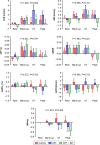Cycle ergometer and inspiratory muscle training offer modest benefit compared with cycle ergometer alone: a comprehensive assessment in stable COPD patients
- PMID: 28919733
- PMCID: PMC5593419
- DOI: 10.2147/COPD.S140093
Cycle ergometer and inspiratory muscle training offer modest benefit compared with cycle ergometer alone: a comprehensive assessment in stable COPD patients
Abstract
Background: Cycle ergometer training (CET) has been shown to improve exercise performance of the quadriceps muscles in patients with COPD, and inspiratory muscle training (IMT) may improve the pressure-generating capacity of the inspiratory muscles. However, the effects of combined CET and IMT remain unclear and there is a lack of comprehensive assessment.
Materials and methods: Eighty-one patients with COPD were randomly allocated to three groups: 28 received 8 weeks of CET + IMT (combined training group), 27 received 8 weeks of CET alone (CET group), and 26 only received 8 weeks of free walking (control group). Comprehensive assessment including respiratory muscle strength, exercise capacity, pulmonary function, dyspnea, quality of life, emotional status, nutritional status, and body mass index, airflow obstruction, and exercise capacity index were measured before and after the pulmonary rehabilitation program.
Results: Respiratory muscle strength, exercise capacity, inspiratory capacity, dyspnea, quality of life, depression and anxiety, and nutritional status were all improved in the combined training and CET groups when compared with that in the control group (P<0.05) after pulmonary rehabilitation program. Inspiratory muscle strength increased significantly in the combined training group when compared with that in the CET group (ΔPImax [maximal inspiratory pressure] 5.20±0.89 cmH2O vs 1.32±0.91 cmH2O; P<0.05). However, there were no significant differences in the other indices between the two groups (P>0.05). Patients with weakened respiratory muscles in the combined training group derived no greater benefit than those without respiratory muscle weakness (P>0.05). There were no significant differences in these indices between the patients with malnutrition and normal nutrition after pulmonary rehabilitation program (P>0.05).
Conclusion: Combined training is more effective than CET alone for increasing inspiratory muscle strength. IMT may not be useful when combined with CET in patients with weakened inspiratory muscles. Nutritional status had slight impact on the effects of pulmonary rehabilitation. A comprehensive assessment approach can be more objective to evaluate the effects of combined CET and IMT.
Keywords: chronic obstructive pulmonary disease; comprehensive assessment; cycle ergometer; exercise performance; inspiratory muscle training; pulmonary rehabilitation.
Conflict of interest statement
Disclosure The authors report no conflicts of interest in this work.
Figures


References
-
- Vogelmeier CF, Criner GJ, Martinez FJ, et al. Global strategy for the diagnosis, management and prevention of chronic obstructive lung disease 2017 report: GOLD executive summary. Respirology. 2017;22(3):575–601. - PubMed
-
- Barnes PJ, Celli BR. Systemic manifestations and comorbidities of COPD. Eur Respir J. 2009;33(5):1165–1185. - PubMed
-
- Spruit MA, Singh SJ, Garvey C, et al. An official American Thoracic Society/European Respiratory Society statement: key concepts and advances in pulmonary rehabilitation. Am J Respir Crit Care Med. 2013;188(8):e13–e64. - PubMed
-
- Hill K, Cecins NM, Eastwood PR, Jenkins SC. Inspiratory muscle training for patients with chronic obstructive pulmonary disease: a practical guide for clinicians. Arch Phys Med Rehabil. 2010;91(9):1466–1470. - PubMed
Publication types
MeSH terms
LinkOut - more resources
Full Text Sources
Other Literature Sources
Medical

